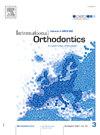Effect of variations in mini-screw diameter, length, tapering, and thread depth on stress-strain distribution and displacement in alveolar bone: A three-dimensional finite element analysis
IF 1.9
Q2 DENTISTRY, ORAL SURGERY & MEDICINE
引用次数: 0
Abstract
Background
Optimizing orthodontic mini-screw design is critical for primary stability. This study investigated the effects of macroscopic parameters—including length, diameter, taper, and thread depth—on stress distribution in surrounding alveolar bone using three-dimensional finite element analysis (FEA) immediately after orthodontic loading.
Methods
We designed a standard mini-screw (8 mm length, 1.6 mm diameter, 0.25 mm thread depth, 1° taper with V-shaped threads) and systematically altered each parameter to create eight additional models. Each mini-screw embedded in bone was subjected to a 2 N static shear load. The stress distribution in the bone and mini-screw, as well as mini-screw displacement under shear loading, were calculated to evaluate primary stability for each design.
Results
Reducing diameter by 0.2 mm increased maximum von Mises stress by 47% in bone and 33% in the mini-screw, whereas increasing diameter by 0.2 mm decreased stress by 10% in both. Other design parameters had smaller effects under shear loading. Maximum bone stress consistently occurred at the mini-screw entry site and around the first thread.
Conclusions
Mini-screw diameter is the most influential factor affecting primary stability, particularly regarding maximum von Mises stress. Our findings highlight the importance of optimizing diameter and structural design at the bone entry site, providing practical guidance for clinical selection and mini-screw design improvements.
微型螺钉直径、长度、锥形和螺纹深度的变化对牙槽骨应力-应变分布和位移的影响:三维有限元分析
背景:优化正畸微型螺钉设计对初级稳定性至关重要。本研究利用三维有限元分析(FEA)研究了正畸加载后,宏观参数(包括长度、直径、锥度和螺纹深度)对周围牙槽骨应力分布的影响。方法设计一个标准的微型螺钉(长度为8mm,直径为1.6 mm,螺纹深度为0.25 mm,锥度为1°,螺纹为v形),系统地改变各参数,创建8个附加模型。每个嵌入骨内的微型螺钉承受2n的静剪切载荷。计算了骨和微型螺钉的应力分布,以及在剪切载荷下微型螺钉的位移,以评估每种设计的初级稳定性。结果减小直径0.2 mm可使骨的最大von Mises应力提高47%,使微型螺钉的最大von Mises应力提高33%,而减小直径0.2 mm可使两者的最大von Mises应力降低10%。其他设计参数对剪切荷载的影响较小。最大骨应力始终发生在微型螺钉进入部位和第一根螺纹周围。结论微螺杆直径是影响初稳定性的主要因素,尤其是对最大von Mises应力影响最大。我们的研究结果强调了优化入骨部位直径和结构设计的重要性,为临床选择和改进微型螺钉设计提供了实用指导。
本文章由计算机程序翻译,如有差异,请以英文原文为准。
求助全文
约1分钟内获得全文
求助全文
来源期刊

International Orthodontics
DENTISTRY, ORAL SURGERY & MEDICINE-
CiteScore
2.50
自引率
13.30%
发文量
71
审稿时长
26 days
期刊介绍:
Une revue de référence dans le domaine de orthodontie et des disciplines frontières Your reference in dentofacial orthopedics International Orthodontics adresse aux orthodontistes, aux dentistes, aux stomatologistes, aux chirurgiens maxillo-faciaux et aux plasticiens de la face, ainsi quà leurs assistant(e)s. International Orthodontics is addressed to orthodontists, dentists, stomatologists, maxillofacial surgeons and facial plastic surgeons, as well as their assistants.
 求助内容:
求助内容: 应助结果提醒方式:
应助结果提醒方式:


